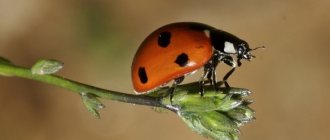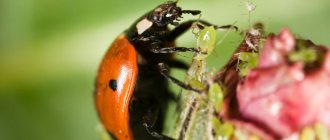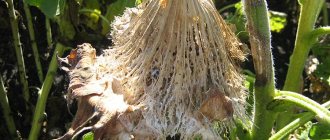- Wild animals
- >>
- Insects
The mole cricket is an omnivorous, voracious insect, distinguished by its large size and scary appearance. A common name among summer residents is cabbage. The harmful beetle causes great damage to the crop, eating all the plants it encounters along the way. The mole cricket is widespread in gardens and summer cottages; it prefers moist and warm soil.
Where did the name “Medvedka” come from?
Mole crickets got their name because of their appearance, large size, brown-brown color and clawed front paws. All this gave reason to compare this insect with the brown
bear
The mole cricket’s second name, “cabbage mole cricket,” comes from its love for young cabbage seedlings. But the third name “mole cricket” comes from the Latin “Gryllotalpa” (properly translated as “mole cricket”) and it is also not accidental. Medvedka is similar to
It is similar to a cricket in its body structure and ability to make sounds, and it is similar to a mole in its ability to burrow into the ground and its extended hands of the front paws, which help dig the ground.
Why a bear?
This pest has a brown color, massive paws, and a fluffy body. This description of the cricket suggests nothing less than the name “medvedka”.
Reminds me of a small clubfooted bear. However, it is not by chance that this cricket is called cabbage. He loves to feast on young shoots of cabbage.
And yet, why do scientists classify the mole cricket as a cricket? The insect makes shrill sounds, very reminiscent of chirping.
Mole crickets are amazing looking individuals. Actually, they are practically not similar to insects. This can be assessed from the photo of the mole cricket. The huge beetle looks more like a locust, only in brown tones.
The mole cricket is widespread everywhere. It does not take root except in permafrost, in northern latitudes. Insects, despite the fact that they have wings, live in underground burrows.
Medvedka: description, structure, characteristics. What does a bear look like?
Mole crickets are arthropod insects and are quite large (for insects) in size. The body length of the mole cricket is from 3.5 to 5 cm. Its body is brownish-brown on top and brownish-yellow below. The body of the mole cricket is covered with thin hairs.
Visual structure of a mole cricket.
The insect's head has a direct or prognathic location in relation to the body. The axis of the body coincides with the axis of the head. The mouthparts are powerful and forward-directed jaws, and next to them are two pairs of tentacles.
The mole cricket's eyes are quite large and clearly visible; they have a facet structure and are located on the sides of the head. On the head itself there are small thread-like antennae.
The pronotum of the mole cricket with the side parts (blades) that hang down is large and flat, it is a distinctive feature of this insect. The head and front part of the body of this creature are covered with a dense chitinous shell, with its help the mole cricket can push and compact the earth when digging holes. Thanks to him, she is somewhat reminiscent of a crayfish.
The abdomen of the mole cricket is thick, it has 1 cm in diameter, and on its top there are anal and genital plates.
The mole cricket has two pairs of wings:
An interesting fact: it is by the venation of the mole cricket's wing elytra that one can distinguish males from females. The larvae of this insect do not have wings.
The mole cricket also has three pairs of limbs, and each of them consists of a coxa, trochanter, femur, tibia and a 3-segmented tarsus. The hind legs are strong, as they are designed for movement and have 1-4 spines on their inner side. The forelimbs, somewhat reminiscent of claws, are essentially a digging apparatus.
Interesting fact: the mole cricket's hearing aid is located on the shins of the forelimbs, just like in grasshoppers, crickets and some other chirping insects.
Description and features of the bear
The mole cricket is an insect related to the cricket. Like him, the heroine of the article is classified as an Orthoptera. This is one of the genera of insects. Medvedka stands out among others:
- Body length from 4 to 10 centimeters. This is taking into account 2 thread-like outgrowths at the end of the abdomen. The appendages are called cerci. The length of 2 antennae on the insect’s head was also taken into account.
- Dark brown on top and greenish on the belly.
- Big eyes. They are located on the cephalothorax of the mole cricket.
- Mouthparts of the gnawing type. The jaws are pushed forward.
- The front legs are transformed into something like shovels or claws. Their flattened structure allows the mole cricket to dig the ground, like moles. It is with its front legs that the pest cuts off young shoots and makes cavities in root crops.
- Wide but shortened elytra. Soft wings protrude from under them. They are located along the back of the insect.
- Large pronotum. It accounts for approximately a third of the length of the mole cricket.
- A hard shell on the cephalothorax. The chitinous layer, like a helmet, covers the insect's head.
Mole crickets differ from other crickets by their shortened antennae, enlarged anterior back and modified forelimbs. In the photo, the mole cricket appears not only in the form of an adult insect, but also as a larva.
Mole cricket larvae are microscopic copies of adults
Juveniles are similar to mature ones, but lack wings and are smaller in size. The mole cricket larva emerges from the egg. It is up to 3.5 millimeters long. The color of the egg is yellowish. A brown coating and greenish reflections are visible.
What sounds does a bear make?
The mole cricket, like the cricket, is a “musical” insect, capable of producing chirping trills that can sometimes be heard at a distance of up to half a kilometer. Sounds are made by
friction of rigid front elytra against each other.
The trills of mole crickets serve communication between them, as well as a very important matter - sexual reproduction of insects, since through the performance of “love serenades” males attract females. Females, by the way, are also capable of chirping. The sound power of the mole cricket is 1.4 mW, while for the cricket this figure is only 0.06 mW.
Mole cricket and cockchafer: how to distinguish
The mole cricket is immediately born in the form of an insect; it is not characterized by the pupal stage. Small brown bear. Wings begin to form during the final stage of development.
But the cockchafer is strikingly different from the mole cricket. Its larva is white. The body consists of visible rings. The larva, reaching 6 cm, tends to curl. Only the head is brown. Also, 3 pairs of paws cannot be ignored. The first two years the larva is absolutely harmless, but then the situation changes. The harvest is in danger of dying.
What does mole cricket eat?
All summer residents know that the mole cricket is the most common pest of vegetable, fruit, berry and garden crops. They damage roots, tubers, seeds, underground parts of plants, and sometimes eat young plants. Mole crickets spoil potatoes, corn, beets, cabbage, tomatoes, cucumbers, eggplants, peppers, turnips, pumpkins, watermelons, melons, grapes and many other crops. In the south, exotic citrus fruits (oranges, tangerines, lemons), peanuts, cotton, and tea also suffer from them. In forests, mole crickets damage the roots of many trees: oaks, beech trees, pine trees, etc.
But do not think that mole crickets are exclusively vegetarians (however, very harmful vegetarians), being omnivores, they also eat some living creatures: earthworms,
ladybugs, dragonflies, beetles and some other smaller insects.
How to prevent it from appearing in the garden beds
Fighting a mole cricket is difficult. Before it multiplies greatly, preventive measures will help, which include the following:
- temporarily stop using fresh cow dung;
- when planting seedlings, frame them with rings made from plastic bottles;
- mulch the beds.
Use poultry to control the pest. Chickens released into the garden after harvesting deal with mole crickets no worse than chemicals. Adding fresh manure to the compost heap will drive out the earthen crayfish. He has to reproduce elsewhere.
The cabbage plant is afraid of the smell of marigolds. They are sown along the perimeter of the beds or stems with leaves and flowers are buried where the pest is especially aggressive. Instead of rejected tagetes, chrysanthemum leaves are used.
The best way to protect your garden is to plow it before frost. The pest has already laid eggs, but in the cold they will die.
The bear does not like the aroma of pine needles. It is used as a mulching material. In addition to the smell, mulch creates uncomfortable conditions for cabbage weed: the temperature of the soil under the needles drops, and the pest loves warmth.
A common situation: a neighbor has brought in manure, and you are afraid that the mole cricket will move on to you. In this case, kerosene helps. Soak a rope in it and stretch it along the boundary. The smell of fuel will scare off the pest and will not allow it to cross the border of the site.
Where does the bear live?
These insects live over a wide geographic range, almost everywhere in Eurasia (with the exception of the northern Scandinavian countries), North Africa, the Americas, and Australia. They are not found only in
Antarctica northern arctic regions.
As a habitat, mole crickets most like wet places: meadows, floodplains. They usually live in underground passages and are often found near irrigation canals and in wetlands.
Clear signs of the appearance of a mole cricket
The appearance of such a pest on a personal plot does not pass without leaving a trace. Sooner or later the insect makes itself known.
The signs are:
- the appearance of passages in the beds, especially noticeable after watering;
- rapid death of plants;
- gnawed root vegetables.
The mole cricket is dangerous because it does not spare anything in its path. She can destroy up to 15 plants per day. On the scale of a personal garden, this is an extremely dangerous figure.
It is important to know! The mole cricket is dangerous because it does not spare anything in its path. She can destroy up to 15 plants per day. On the scale of a personal garden, this is an extremely dangerous figure.
Lifestyle of mole cricket (kapusyanka)
These insects prefer to lead a secretive and nocturnal lifestyle, hiding in their burrows during the day and going out to hunt at night. Their presence in a garden plot can be determined by winding, loosened ridges of earth, small holes in the ground, and, of course, by healthy plants that suddenly begin to die for no reason at all.
This is what mole cricket tunnels look like.
It is at night that mole crickets spoil/eat plants; they are also able to fly over considerable distances in search of food (usually they are attracted to bright light). They are also capable of not only flying, but also swimming.
Prevention of occurrence
A typical insect light trap used to control mole crickets
To protect the area from the appearance of unwanted guests in the form of mole crickets, a number of measures should be taken. Most of them are in the nature of general recommendations carried out when counteracting various pests.
Such measures include:
1 Planting the repellent plants described earlier on the site
2 Digging of areas along the perimeter with furrows with naphthalene or special means Medvetsid
3 Systematic inspection of all types of soil and fertilizers brought to the site (manure, humus, black soil, sand, etc.) to search for mole crickets, their eggs and larvae. Approximately a third of the cases of pest penetration into plots occur with imported soil material
4 Regular weeding and loosening of the soil. Weed removal
5 During the mole cricket’s flight (mid-to-late May), use specialized light traps that are suspended above containers (you can use a regular basin) with a water-kerosene composition. Insects, flying towards the light, stumble upon a trap and fall into a basin, where a layer of kerosene located above the water envelops their bodies, causing suffocation and death
6 Since the mole cricket lives exclusively in acidic soils, it is recommended to carry out annual deacidification of the site by adding dolomite flour or lime to the soil.
At the same time, it must be said right away that some methods of preventing the appearance of pests are not applicable to mole crickets. For example, burying metal mesh around the perimeter of the site, which is very effective against moles, will not have any effect on mole crickets.
Firstly, mole crickets are somewhat smaller than moles, and secondly, unlike moles, they can move both on the ground and in the air.
Natural enemies of mole crickets
Of course, the mole cricket has its own enemies in natural conditions, among them rooks, starlings, crows,
hedgehogs, lizards, moles, ants (they pose a threat to mole cricket larvae). Also among pets, the enemy of this insect harmful to the garden is the cat, which can hunt and eat mole crickets like mice and rats, which is of great benefit to the household.
Reproduction and lifespan
A mole cricket is an insect or animal that makes a nest in the ground. Its walls are crumpled soil. Inside is a chamber with eggs. The nest is located close to the surface, often on the sunny side of the garden bed. The breeding season for mole crickets begins in May and ends in the first half of June. At this time, insects are especially vocal at night.
It takes a month for the larvae to emerge from the eggs. Newborns are wingless and have long, grasshopper-like hind limbs. Young animals also have weak jaws. They are used only to snack on small roots, small worms, and chew compost.
However, the jaws of adult mole crickets are not enough to bite a person. But the insect can pinch a finger with its front, modified limbs. The spiky growths on the pest's legs dig into the skin like splinters. Hence the frequent question: does a mole cricket bite ? Gardeners mistake something for a bite that actually isn't one.
Inexperienced gardeners often confuse cockchafer larvae with mole cricket larvae
Transforming into adults, mole cricket larvae molt 8-10 times, acquiring a new “shell.” It takes 1-2 years to mature. There are still 1.5 left for reproduction. Mole crickets rarely live more than 3.5 years.
If the insect does not die a natural death, it will be eaten, and not always by birds. In Asian countries, for example in Thailand, mole crickets are considered a delicacy. In other countries, insects are taken for fishing as bait. This is how mole crickets end up in the mouths of pikes and perches.
Types of mole crickets, photos and names
Different types of mole crickets practically do not differ from each other, neither in appearance, nor in habits and way of life. They can be distinguished biologically only by the number
chromosomes. Next, we will describe in detail some common types of mole crickets.
Mole cricket
In fact, this is the most common species among these insects. Widely distributed in Europe (with the exception of Scandinavia), lives in a number of Asian countries and northern Africa. Almost everything that we describe here about mole crickets, first of all, concerns the common mole cricket.
African mole cricket
It is slightly smaller in size than the common mole cricket, the body length is 2.5-3.5 cm. It has a brown-yellow body color. Lives in the African tropics and subtropics, but in addition to the “Black
continent" is also found in Southeast Asia and even on the Japanese islands.
Ten-toed mole cricket
This species is distinguished by its small size - from 1.9 to 3 cm. It inhabits both Americas, and it is believed that initially they were found only in North America, but gradually penetrated into South America.
Steppe mole cricket
In appearance it is an exact double of the common mole cricket. This species prefers steppe terrain as a habitat; it lives in the steppe belt of our country, Ukraine, southern Russia, Kazakhstan, Turkmenistan and a number of other Middle Eastern countries.
Application of chemistry
Sealing mole cricket burrows with cotton wool
The chemical industry produces a fairly large number of drugs used to kill mole crickets.
Almost all of them are broad-spectrum insecticides that can also destroy the following species:
- larvae of May beetles and bronze beetles
- wireworm larvae and adults
- black garden ants (breeding aphids and mealybugs)
A description of the drugs and the features of their use is given in the table:
| A drug | Active substance | How to use |
| Medvetox | Spectracid 25E | It is a red granular powder. Harmless to plants and many other species of earth animals, in particular earthworms. Placed between rows in long furrows up to 5 cm deep. Validity period is about 15 days. The action begins a few hours after application. |
| Anti-Medvedka | Imidacloprid | Large and small white granules. Consumption - no more than 20 g per 1 hundred square meters. Placed on the surface between the beds during planting. |
| Medvecid | Imidacloprid | Small purple granules. They are located in furrows no more than 3 cm deep between rows. The distance between the granules is 50-100 cm. Consumption is 10g per 1 sq. m. |
Rembek | Imidacloprid and chlorpyrifos | Presents a malfunctioning strong-smelling bait. Consumption - no more than 25 g per 1 hundred square meters. Baits are placed in and around holes. |
| Boverin | Beauveria bassiana spores | A suspension is made from the substance, which is applied to plants and around mole cricket burrows. The spores of the fungus, falling on the skin of an insect, begin to germinate inside its body, which leads to death within a few days. Repeated treatment is carried out after 1-2 weeks. |
| Phenaxin-plus | Phosphothion | It is a strong-smelling white-yellow granule. Their laying is carried out at the stage of sowing seeds. Repeated treatment - 3 weeks after sowing (duration of the drug); in this case, the granules are simply placed near the stems. |
Any of the listed drugs (except Boverin) can be used in a mixture with edible bait - oatmeal, buckwheat or pearl barley porridge. Sunflower oil is also added to the bait. In the evening, the resulting mixture is laid out near the bear's burrows in the amount of 10-15 g per hole.
In addition, to combat mole crickets, acetylene is used, which is poisonous for the insect. To do this, 5 g of calcium carbide is placed in each hole and all holes are sealed with cotton wool or soft cloth, covered with earth on top.
When the substance reacts with water (in the form of rain or irrigation water), it decomposes into acetylene, which fills the mole cricket's burrows and passages. The gas quickly kills the insect.
Kerosene can also be used against mole crickets. However, this comes with some problems: due to the relatively high toxicity of the drug, it is not recommended for use in large quantities. You can fill no more than 1-2 holes on the site with kerosene; Up to 50 ml of substance is consumed for each hole.
Mole cricket reproduction
The mating season for mole crickets begins in the spring, after their mass exodus from the burrows in which they spent the winter. Moreover, the mating process itself takes place underground, in burrows. In summer, offspring appear.
Both female and male mole crickets carefully prepare for the birth of future children; they dig complex and branched underground labyrinths and, at a shallow depth (about 5 cm from the surface), create spherical nests 10 cm in diameter. The female mole cricket lays from 300 to 600 eggs in these nesting sites. All this time, the female does not leave her eggs, maintaining the desired temperature and providing ventilation; for this purpose, she continually clears the passages, eats up the roots of plants that cast a shadow on the eggs, etc. All this is critical for the survival of the offspring. The mole cricket eggs themselves are somewhat reminiscent of millet grains; they are oval in shape, yellowish-gray in color and no more than 2 mm in size.
After 10-20 days, the mole cricket eggs begin to hatch into larvae, also known as nymphs, which are small gray six-legged wingless creatures. Otherwise they look similar to adults. For the first 20-30 days, the larvae are under the close protection of the mother, and at the end of this period, the female mole cricket, which gave birth to abundant offspring, unfortunately dies. At this time, the larvae are already crawling into burrows, starting to dig their own holes and look for food. Their development and transformation into a full-fledged adult takes from 1 to 2.5 years.
Damage caused by mole crickets
The mole cricket most often attacks vegetables, especially the underground parts of seedlings; it does not feed on weeds and grass, preferring cultivated plants. Most often affected:
- tomatoes;
- radish;
- beet;
- potato;
- cucumbers;
- bush roots;
- flowers;
- parsley;
- carrot;
- cabbage;
- eggplant;
- pepper;
- melons;
- radish.
The peculiarity of the mole cricket is that it spends most of its time underground, digging tunnels in the ground, building nests for laying eggs. It prefers a moist and loose substrate, in such conditions it is located close to the soil surface: 5-10 cm, if there is little moisture it can burrow to a depth of 0.5 m or more.
Wintering of the cabbage also takes place in the soil, very far from the surface, about 2 m. With the arrival of warm weather, rapid and massive reproduction begins. The appearance of mole crickets in the garden is indicated by areas with cut vegetation; females remove it to better warm up the clutches located in the ground. The eggs mature in 10-14 days and at first the larvae feed on the mother’s saliva, and after 7-8 days they increase in size and begin to gnaw on stems, tubers or the root part of plants, along with adults. The offspring are very voracious and also cause great damage to the crop. The insect can single-handedly destroy up to 14-15 bushes per night.
The best time to control the pest is spring or autumn.
In warm regions, mole crickets are not averse to eating tea, citrus fruits and peanuts. In the garden, apple, pear, cherry, apricot or peach trees may be affected. In the forest there are young oaks, pines, and spruces. The larvae have poorly developed jaws, so they feed on small insects, seeds and young plant roots.
How to deal with a mole cricket
The fight between this insect pest and the gardener has been going on since ancient times; the arsenal of the fight against mole crickets includes both time-tested folk remedies and modern means of disinfestation. We will look at this in more detail later.
Chemical preparations for mole crickets
You can make bait for it from steamed grains of corn, oats, barley, wheat or rye, not forgetting to add poison there. Previously, such strong agents as zinc phosphide and dust (DDT) were added to such baits. Now, for this purpose, much safer special poisons are used exclusively for mole crickets, for example, Medvetoks, they do not harm the soil or earthworms, but only kill pests.
Ready-made bait can be purchased at a specialized store. It is optimal to apply it to the soil in early spring, a week before sowing crops.
Agrotechnical measures
Agrotechnical measures, such as deep spring and autumn plowing, regular loosening of the soil, also help get rid of mole crickets in the garden or garden plot.
Destruction of mole crickets by mechanical means
You can try to fight with the mole cricket and various mechanical means.
- Set up traps for them in manure pits. The fact is that they like to spend the winter in manure. And when they gather in the manure pit in winter, it should be scattered around the garden. The mole crickets located there will die from the cold. True, this is only relevant for places with cold climates.
- In a place where mole crickets accumulate, dig a jar or bottle into the ground. Then pour beer in there as bait. Once they get there, the mole crickets will no longer be able to get out.
- Set up light traps for mole crickets - place garden lanterns, and under them containers filled with water and kerosene. Since mole crickets fly towards the light at night, when they hit the lamp, they will fall into the liquid prepared for them.
- You can pour water and sunflower oil into the holes made by pests. Water will push them to the surface, and oil will not allow them to breathe.
Fighting mole crickets with folk remedies
- – You can try to scare away the mole crickets with unpleasant odors. These come from: rotten fish, onion skins, wormwood, garlic cloves and mint.
- You can also water the soil with diluted bird droppings. Chicken will also work.
- Plant plants that the mole cricket cannot tolerate: garlic, chrysanthemums, perennial cloves.
Precautions when fighting mole crickets in the garden
When using strong chemicals against mole crickets, you must remember to be careful. Instead, other plants, soil or pets should not be harmed.
Insect lifestyle and habitat
Mole cricket is a pest hiding underground. Indirect signs of the presence of an insect are the passages it has dug and the soil loosened at the surface. However, the mole cricket already chooses loose, light, fertile soil. The latter quality is necessary for the abundance of plants on which the insect feeds. The first two qualities of the soil make it easier for the mole cricket to move through it.
In addition to looseness, the pest evaluates soil moisture. Irrigated land is preferred. Mole crickets appear from under it at night. Sometimes insects fly into the light. Males chirp at the same time, but less elegantly than crickets. The voices of mole crickets can be heard at a distance of 600 meters.
Chirping serves as a means of communication. Insects prefer to communicate at night. Daytime silence is associated with a fear of birds. The birds calculate the location of the mole crickets. Illumination is an additional guideline. At night, when birds hear mole crickets, they cannot see them.
The first visits of mole crickets to the surface in most of Russia are recorded in May, and the last in September. Insects spend the winter at a meter depth. The usual habitat of the pest is 20 centimeters below the surface of the earth. This is the adult level. Juveniles are found at a depth of 5-10 centimeters and winter at 25 centimeters.
The insect's passages descend deep into the ground at an angle of 50-60 degrees. The immersion of pests in the soil complicates the answer to the question of how to deal with mole crickets . Juveniles and larvae can be provided to chickens and wild birds by digging up the top layer of soil in early spring.
Half-asleep insects will not have time to escape from hungry birds. But what to do with adult pests hiding at a considerable depth? More on this in the final chapter. In the meantime, let’s find out what the mole cricket can do to the site.
Interesting facts about mole cricket
- Gourmets in South-East Asia sometimes consume these insects as a delicacy. Moreover, they are prepared fried, stewed, pickled, with the addition of seasonings or even without them.
- Sometimes the mole cricket brings some benefit, as it destroys the larvae of cockchafers and some other insects that eat plants
- Surprisingly enough, there are benefits from Medvedka in the field of pharmaceuticals as well. So a powder is made from it, which is used as one of the components for a cure for tuberculosis.
Mole cricket nutrition
Worms, small insects, larvae, manure, humus, roots, stems, plant seeds. This is what mole crickets eat. The diet of adults and young animals is the same. However, due to their size, young insects are more often content with plant food, and mature ones with animal food.
Among beetle larvae, mole crickets prefer offspring of the Colorado, May beetles and ladybugs. While searching for prey, the pest tears up the soil so much that cultivated crops die from damage to the root system. In other words, mole crickets do not so much eat as they destroy the crop.
The mole cricket is considered one of the most harmful pests of agricultural crops.
Considering the benefits of mole crickets in folk medicine, some people deliberately breed the insect in their plots or at home. Sometimes, an insect is kept, as they say, for the soul, like some types of spiders and cockroaches.
The question arises of what to feed your pet at home. The animal refuses vegetables, apples, cucumbers, potatoes and strawberries. They are, according to many amateur gardeners, a delicacy for mole crickets. However, in reality, pets choose:
- minced meat
- Gammarus crustacean sold as fish food
- small grain porridge
- small insects, which at home are usually served crushed to the mole cricket table
When choosing food for mole crickets, it is important to avoid strong-smelling foods. Insects do not like strong odors. This, by the way, suggests a way to deal with an animal if it is a pest, and not a medicinal raw material or a pet.
Lifestyle
The mole cricket lives on loose, fertile soils, spending most of its life underground. At night it comes to the surface, most often in search of food. Under the ground it creates pantries with supplies and nests for laying eggs.
Around the nests there are usually long passages - burrows, in which the insect guards the clutch and nymph larvae. The passages are dug at a certain angle, the exits of the burrows lead to the surface in different places in the garden. The depth of labyrinths and branches is up to 20-25 cm.
It feeds on roots, as well as young plant sprouts, root crops, earthworms, and small insects. When garden strawberries ripen, cabbage berries devour the berries; they also willingly eat carrion (apples, plums, cherries).
For the winter, they settle in warm heaps of manure, humus, and burrow into the soil to a depth of 1.5 meters. Young individuals of the cabbage mushroom overwinter at a depth of 20-30 cm.
Is there any benefit from mole cricket?
It turns out that an insect can serve for the benefit of humans:
- Chinese scientists have long used the healing properties of cabbage to treat tuberculosis. Based on their research, the causative agent of this terrible disease dies as soon as it enters the pest’s body.
- Digging in the ground and digging tunnels, the mole cricket helps enrich the soil with oxygen.
- It can serve as bait when fishing.
- Being in its natural habitat, the mole cricket eats the larvae of other insects, thereby maintaining balance and protecting the plants.
In some countries, this insect is eaten, fried, stewed and even pickled, and generously flavored with oil and seasonings to improve its taste.











